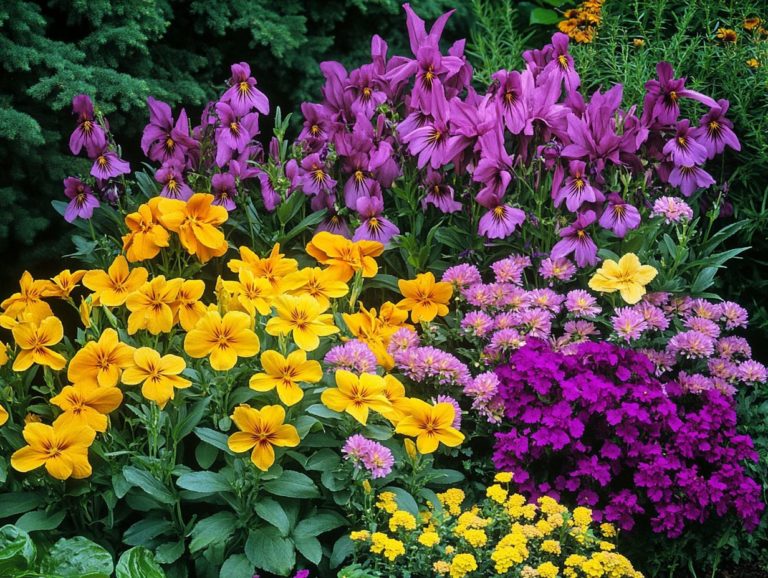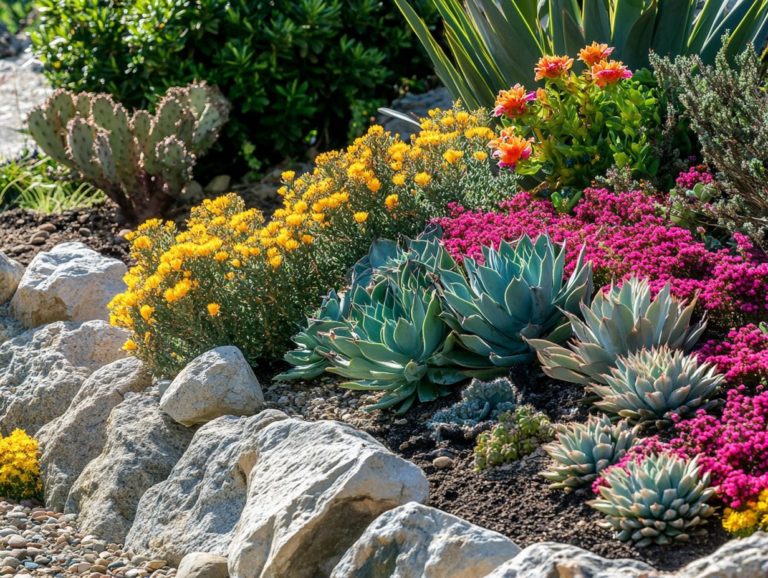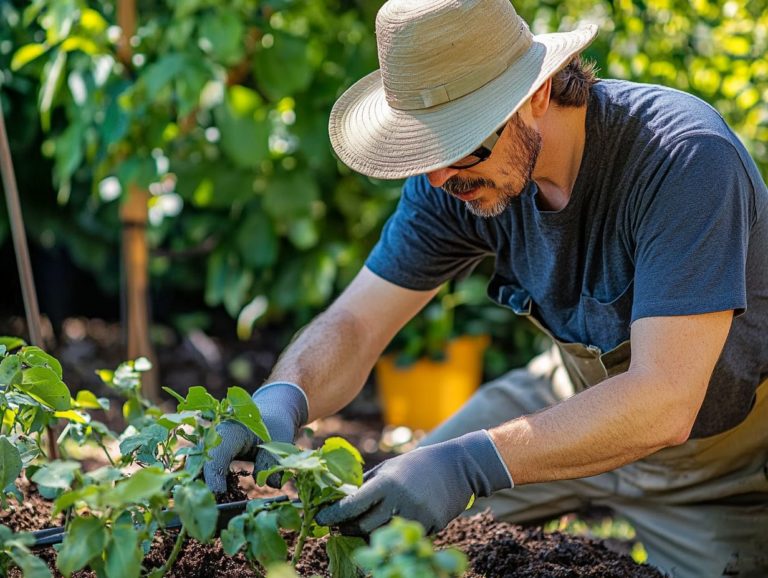How to Create a Drought-Resistant Oasis
As climate change accelerates, the necessity for sustainable landscaping practices has reached unprecedented levels.
Drought-resistant landscaping not only conserves water but also elevates the aesthetic appeal of your outdoor space.
This article delves into what drought-resistant landscaping really involves, highlighting both environmental and cost benefits while offering practical design tips for creating your own green oasis.
From choosing the perfect plants to implementing effective water-saving techniques, you ll find guidance on how to maintain a thriving, eco-friendly landscape.
Ready to turn your yard into a drought-resistant paradise? Let s get started!
Contents
- Key Takeaways:
- Understanding Drought-Resistant Landscaping
- Benefits of Creating a Drought-Resistant Oasis
- Designing Your Drought-Resistant Oasis
- Maintaining Your Drought-Resistant Oasis
- Tips for a Successful Drought-Resistant Oasis
- Frequently Asked Questions
- 1. What is a drought-resistant oasis and why should I create one?
- 2. Where should I start when creating a drought-resistant oasis?
- 3. What are some key elements to include in a drought-resistant oasis?
- 4. Can I still have a lush and beautiful outdoor space with a drought-resistant oasis?
- 5. How can I maintain my drought-resistant oasis?
- 6. Can I still use fertilizers and pesticides in a drought-resistant oasis?
Key Takeaways:

- Understand the concept of drought-resistant landscaping and its importance in conserving water and promoting sustainability.
- Utilize drought-tolerant plants and water-saving techniques to design an oasis that is resistant to drought and requires minimal maintenance.
- Regular care and consideration of climate and soil conditions are necessary for maintaining a successful drought-resistant oasis.
Understanding Drought-Resistant Landscaping
Understanding drought-resistant landscaping is crucial for crafting a sustainable and vibrant garden oasis, particularly in areas like the San Luis Valley, where the semi-arid climate presents its own set of challenges.
This approach transcends mere water conservation; it involves thoughtful planning and the selection of drought-tolerant plants that truly thrive in such environments.
By embracing these principles, you can cultivate a flourishing landscape that not only reduces the need for extensive irrigation but also enhances biodiversity and promotes overall environmental health.
What is Drought-Resistant Landscaping?
Drought-resistant landscaping helps you create stunning outdoor spaces that require minimal water. By adopting techniques like Xeriscaping which reduces or eliminates the need for irrigation and selecting plants that thrive in arid conditions, you can design a landscape that s both beautiful and resource-efficient.
This approach highlights the importance of integrating water-efficient practices for a sustainable environment. Your gardens and yards will conserve precious water while also enhancing local biodiversity.
By choosing native or drought-tolerant plant species, you can cultivate vibrant spaces that flourish even with limited moisture, building resilience against climate variability.
Xeriscaping plays a pivotal role here. It employs strategies such as efficient irrigation, mulching, and soil improvement to cut down on evaporation and promote water retention.
Ultimately, these deliberate choices not only reduce your water consumption but also contribute significantly to a healthier ecosystem, decreasing runoff and bolstering soil stability.
Benefits of Creating a Drought-Resistant Oasis
Creating a drought-resistant oasis provides a wealth of benefits for both the environment and your wallet. By enhancing water conservation efforts, you can reduce the need for costly maintenance strategies. For detailed guidance, check out this resource on how to plan a drought-resistant community garden, which is especially crucial in water-scarce regions like the San Luis Valley.
Embracing this approach fosters sustainability and positions you as a steward of the land, ensuring that resources are used wisely and efficiently.
Environmental and Cost Benefits
The environmental and cost benefits of adopting drought-resistant landscaping practices are truly remarkable. You can achieve significant water savings while embracing drought-tolerant plants that require minimal upkeep.
This approach not only conserves precious water resources but also enhances biodiversity by cultivating habitats that support a variety of local species.
As your garden flourishes with native plants, it contributes to healthier ecosystems, balancing soil nutrients and providing vital food sources for pollinators.
By reducing irrigation needs, you can enjoy substantial cost savings on water bills while simultaneously cutting down on the necessity for chemical treatments and fertilizers.
The long-term advantages of these sustainable practices highlight the importance of transitioning to a more eco-friendly landscaping model that aligns seamlessly with environmental priorities.
Start making these changes today and watch your garden thrive!
Designing Your Drought-Resistant Oasis

Designing your drought-resistant oasis means crafting a harmonious landscape that elevates the beauty of your property while embracing water-saving methods.
By incorporating drought-tolerant plants that flourish in a semi-arid climate, you can create a stunning outdoor space that thrives even in challenging conditions.
Choosing Drought-Tolerant Plants
Choosing drought-tolerant plants is essential for crafting a resilient garden that embodies the principles of a landscaping method that reduces the need for watering. This method lets you explore diverse California native species, including fragrant options like lavender and Russian sage, which flourish with minimal water.
To enhance the sustainability of your landscape, it’s vital to consider factors such as soil type, sun exposure, and local climate.
For instance, succulents like Agave and Echeveria prove to be outstanding choices due to their remarkable ability to store water.
Meanwhile, other natives like California poppy and manzanita not only infuse your garden with vibrant color but also serve as a haven for pollinators.
These plants require minimal maintenance and can significantly lower water usage, translating to reduced utility bills and a lesser environmental footprint.
By embracing these selections, you re not just creating a beautiful outdoor space; you re also reflecting a commitment to ecological wisdom and aesthetic appeal.
Implementing Water-Saving Techniques
Implementing effective water-saving techniques, such as drip irrigation, morning watering schedules, and mulching, is essential for cultivating a drought-resistant oasis. To further enhance your garden, learn how to incorporate drought-resistant plants while also improving soil health and moisture retention.
These methods minimize water wastage and actively contribute to a thriving ecosystem by fostering healthier root systems and improving soil structure.
Drip irrigation delivers water directly to your plants’ roots, minimizing evaporation and runoff especially beneficial in arid conditions.
By adhering to morning watering schedules, you take advantage of cooler temperatures, significantly reducing water loss.
Mulching provides a protective layer that retains moisture and suppresses weed growth, allowing your plants to access vital nutrients without competition.
Together, these innovative practices support sustainable floral landscapes and bolster your garden’s resilience against the increasing challenges of climate change.
Maintaining Your Drought-Resistant Oasis
Maintaining your drought-resistant oasis demands consistent attention and the application of effective maintenance strategies, such as learning how to create a drought-tolerant garden, to preserve the longevity and vibrancy of your water-wise landscape.
By utilizing techniques such as organic mulching and targeted plant care, you can cultivate a thriving environment that flourishes with minimal resources.
Proper Care and Maintenance Tips
Proper care and maintenance of your drought-resistant oasis require a thoughtful approach. Implementing strategic watering techniques and utilizing organic mulch can significantly enhance soil quality while minimizing evaporation. Additionally, learning how to design a drought-tolerant garden can further optimize your efforts.
To ensure the longevity and vitality of your remarkable plants, adopting a watering schedule that mimics natural rainfall patterns is key to success!
This often means allowing the soil to dry out between watering sessions, encouraging deeper root growth and preventing waterlogging.
Aim for the early morning hours to reduce evaporation rates.
Adding a layer of organic mulch, such as wood chips or straw, helps retain soil moisture and suppresses weed growth, protecting your garden’s delicate ecology.
Seasonal care involves periodic assessments to determine if any adjustments are needed based on changing climate conditions and the various stages of plant growth, fostering a truly resilient landscape.
Start transforming your garden today! Every small step counts towards a beautiful, sustainable landscape!
Tips for a Successful Drought-Resistant Oasis

To create a thriving drought-resistant oasis, consider strategies that prioritize water efficiency. You might also explore how to create a wildlife-friendly drought garden, focusing on the unique climate and soil conditions in your area, especially in regions like the San Luis Valley.
Maximizing Water Efficiency
You can maximize water efficiency in your oasis by using advanced irrigation methods. These techniques ensure drought-resistant landscape plants receive the moisture they need while minimizing waste.
Smart controllers adapt irrigation schedules based on weather, soil moisture, and plant needs. They optimize both the timing and amount of water applied, reducing unnecessary usage.
Drip systems deliver water directly to the roots, minimizing evaporation. This method conserves water and promotes healthier plant growth, showing how technology can enhance landscape management.
Considering Climate and Soil Conditions
Local climate and soil conditions are crucial for your oasis. These factors directly affect your choice of drought-tolerant plants.
Start by analyzing local climate data like average rainfall and temperature extremes. Knowing these helps you choose plants that thrive with minimal water.
Next, evaluate soil types in your area. Understanding drainage and nutrient availability will clarify which plants will thrive.
Use these insights in your landscape design. Choose native plants to create a sustainable and resilient garden, which reduces the need for excessive watering.
Frequently Asked Questions
1. What is a drought-resistant oasis and why should I create one?
A drought-resistant oasis is a garden designed to thrive in dry conditions. It reduces excessive watering, preserves water resources, and saves on water bills.
2. Where should I start when creating a drought-resistant oasis?

Start by assessing your site. Identify challenges like sun exposure, soil conditions, and water availability to determine suitable plants and materials.
3. What are some key elements to include in a drought-resistant oasis?
A drought-resistant oasis includes plants, hardscaping features, and efficient irrigation systems to conserve water. To learn more about creating such a space, check out how to get started with drought-resistant gardening. Key elements are:
- Native plants
- Mulch to retain moisture
- Efficient irrigation systems like drip irrigation
- Permeable paving materials
- Shade structures and rainwater harvesting
4. Can I still have a lush and beautiful outdoor space with a drought-resistant oasis?
Absolutely! A drought-resistant oasis can be both lush and beautiful.
With careful planning and plant selection, you can create a vibrant outdoor space that conserves water. Incorporate plants with different textures, sizes, and colors to add interest.
Non-plant elements like sculptures, water features, and seating areas can enhance the overall look of your oasis.
5. How can I maintain my drought-resistant oasis?
Once established, your drought-resistant oasis requires less maintenance than traditional gardens.
Regular checks on irrigation systems, weed removal, and plant pruning will keep your oasis in shape. Monitor weather patterns and adjust watering schedules as necessary.
Consulting a professional landscaper can also help maintain a healthy and thriving oasis.
Start planning your drought-resistant oasis today for a beautiful tomorrow!
6. Can I still use fertilizers and pesticides in a drought-resistant oasis?
Generally, it’s best to avoid fertilizers and pesticides in a drought-resistant oasis. These products can harm the environment and counteract your water-saving efforts.
Focus on building a healthy ecosystem that naturally repels pests and diseases. If needed, choose organic and eco-friendly alternatives to keep your oasis thriving.






